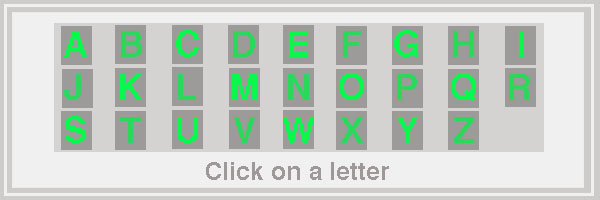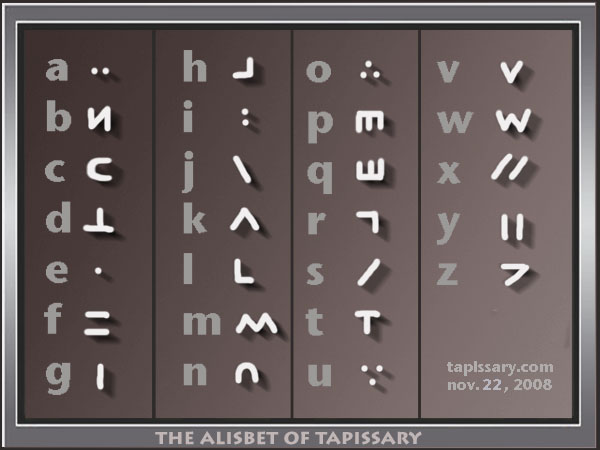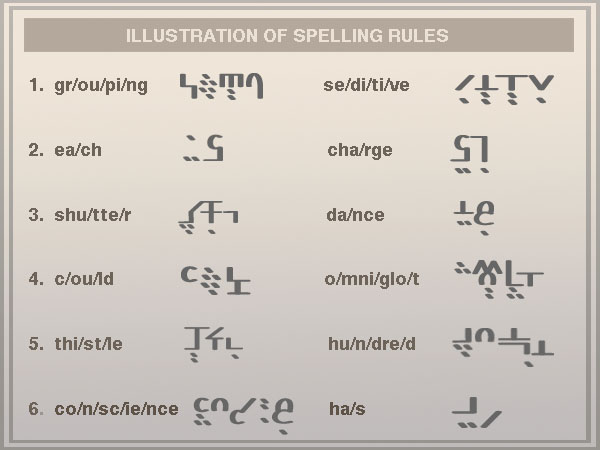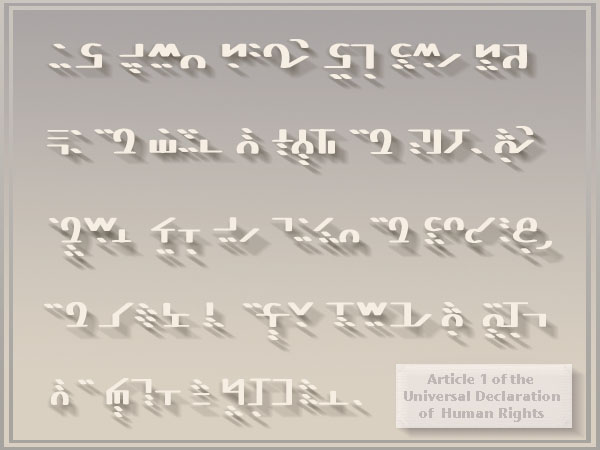

THE ALISBET OF TAPISSARY

SPELLING RULES
1. Letters are grouped in vertical pairs, such as gr/ou/pi/ng, se/di/ti/ve.
2. The alisbet grafts consonant pairs together. Notice how the CH in 'each' and 'charge' look like a single letter. The C is at the top, the H braces it from below. The RG looks deceptively like an R at first, but its length takes the whole vertical space of a pair and therefore signals that the R is on top, and the G is added below it.
3. If a vowel comes after the pair, it is attached onto the bottom of the pair yielding a vertical column with three letters: shu/tte/r, da/nce. A consonant is never placed at the bottom of a three letter column.
4. Consonant and/or vowel clusters of two or more letters bond together. Therefore, in a word such as 'could', the ou and the ld are paired off: c/ou/ld. Another example binds the consonants in o/mni/glo/t.
5. If a cluster has 3 or more letters, the divisions are chosen by 1) common values (ex: thistle > thi/st/le, where st is more common than tl, so that you would not write it th/is/tle). 2) Separation by way of syllables: hu/n/dre/d.
6. Finals and Medials. When a consonant or vowel is unpaired in the middle or beginning of the word, as you've seen in hu/N/dre/d or in co/N/sc/ie/nce, that letter is kept in the upper position of the vertical column. If the singled out vowel or consonant comes at the end of a word, also seen in the example of hu/n/dre/D or ha/S, it drops to the base level of the vertical column.
SOME SPECIFIC LETTERS:
7. The letter Z can connect to no other letter than itself. Pizza but not 'stanza'.
8. When the letter R is at the bottom of a pair, its vertical line extends below the base line, like a tail.
9. When the letter G is compounded with a consonent with a horizontal surface, its vertical body is written to the right.
10. The letter H cannot be the top letter of a consonant cluster. It can only join another consonant as the bottom of the pair. Ex: ghost.
11. The letter L can join other consonants with horizontal surfaces, however, to keep it distinguished from the G, its vertical line is written to the left. Ex: pulp.
12. When merged with another consonant of horizontal joint, the D simply remains a vertical line which is centered in the middle of the horizontal joint. Drip.
NOTE: I am planning to show the above examples 7 - 12 in an image when I next get time. For now, my apologies for the confusing explanation. It will make sense once you see a picture.

Begun on Nov. 20, 2008, it took me two days to get this alphabet to where I wanted it. The alisbet is based loosely on the abjad function of Hebrew. However, the shapes of the letters are derived primarily from the Latin alphabet. Alis- refers to Alice in Wonderland, a version of the story I'm currently writing in my invented language of Tapissary. Tapissary is a hieroglyphic language with a syllabary support. I decided to replace the complex syllabary with an alphabet to make things easier on my readers for this particular story project. The alisbet accompanies Tapissed glyphs in texts, and take grammatical markings as well. In the sample text below, I applied the alisbet like a code for English.
All the vowels are dots. I'm finding that if I only skim the vowels while reading, the consonantal structure makes reading a new alphabet rather easy.

∆ All human beings are born free and equal in dignity and rights. ∆ They are endowed with reason and conscience and /\ should act towards one another in a spirit of brotherhood.
TRANSLITERATION:
Each human being's charge comes born free and equal in dignity and rights. One's endowed state has reason and conscience, and should go active towards one another in a spirit of brotherhood.
